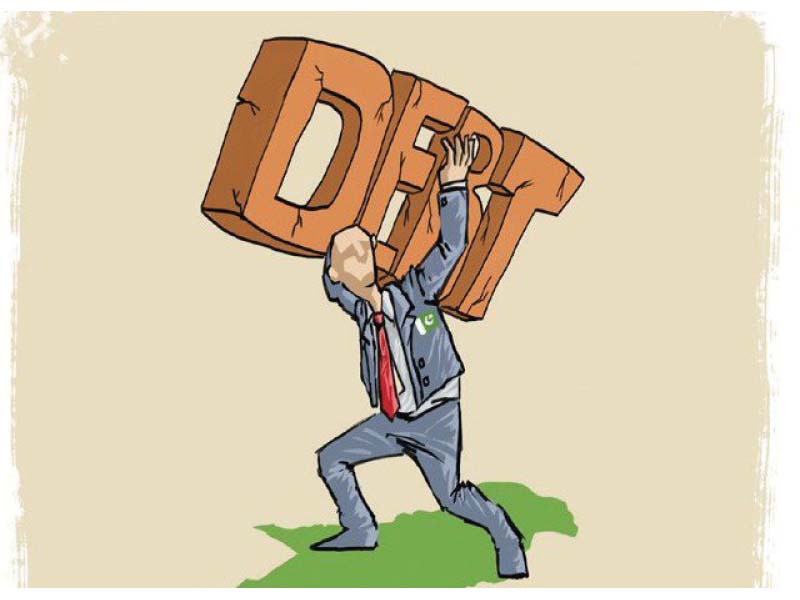
ISLAMABAD: Pakistan’s all debt sustainability indicators have turned topsy-turvy in the last fiscal year, suggesting that the country faces serious challenges to foreign debt repayment and is also exposed to high refinancing risks due to a short debt maturity period.
The Public Debt Management Risk Report of June 2018, released by the Ministry of Finance, showed that most of the indicators moved further towards dangerous levels while three breached the red line, set in the medium-term debt strategy.
The report covers public debt up to June 2018 when the federal government’s gross public debt stood at Rs24.95 trillion, accounting for 72.5% of the total national output.
The results showed that the last Pakistan Muslim League-Nawaz (PML-N) government did not implement the Medium Term Debt Management Strategy 2016-19, which was aimed at striking a balance between risks and the cost of acquiring new debt.
The debt management strategy that Pakistan adopted under the last International Monetary Fund (IMF) programme sets target ranges for foreign currency, refinancing and interest rate risks.
Foreign exchange risks
In what appears to be an alarming change, the finance ministry report showed that Pakistan’s short and long-term debt maturing in the current fiscal year 2018-19 increased to 80.6% of the total liquid foreign currency reserves by June 2018. This ratio was only 27.7% just a year ago, which indicated the danger of default.
The main reason for the high ratio is repayment of Eurobonds and SAFE deposits of China, the sources said.
In June 2018, the country’s official liquid foreign currency reserves stood at $9.8 billion, which slid to $8.4 billion by the end of September.
After wasting about one and a half month, the Pakistan Tehreek-e-Insaf (PTI) government has decided to approach the IMF to avoid default on international payments.
The foreign currency debt as a percentage of total debt increased from 28.4% to 32.2% by June 2018. The debt strategy gives the safe range at 20% and the maximum range at 35%.
Refinancing risks
The report showed that both the refinancing indicators are pointing towards high risks. Average time-to-maturity of the public debt came down from three years and eight months to three years and six months by June this year.
The deterioration was on account of both domestic and external debts. The average time-to-maturity of external debt decreased from eight years and four months to just seven years and six months.
In 2013, when the PML-N government came to power, the maturity period of external debt was 10 years.
Domestic debt’s average time-to-maturity fell from two years to just one year and six months by the end of last fiscal year, according to the report. The results show that the last government deviated from the path of prudent debt management.
The indicator of debt maturing in one year has also deteriorated. In June 2017, the public debt maturing in one year was 42.1% of the total debt, which has now increased to 48.9%. This will massively increase the government’s debt servicing cost as the State Bank of Pakistan (SBP) is set to further increase interest rate to win over an IMF bailout programme.
The deterioration was on account of both domestic and external debt. The ratio of domestic debt maturing in one year increased from 55.6% to 66.3% - which is above the danger level of 65%. The ratio of external debt maturing within one year increased from improved from 8% to 12.4% of the total debt.
Interest rate risks
Another critical indicator - the average time to re-fixing of public debt - has also worsened. The period has dropped from three years and five months to three years and two months, heightening the interest rate risks.
The external debt’s average time to re-fixing also reduced from seven years and five months to just six and half years.
The domestic debt re-fixing reduced from two years to one and half years. The average time to re-fixing is a measure of weighted average time until all the principal payments in the debt portfolio become subject to a new interest rate.
Due to growing dependence of floating interest rate debts, the ratio of fixed rate public debt - debt issued at a fixed rate as opposed to the one pegged with Kibor -has come down from 61.2% in 2017 to 53.4% by June this year.
The external fixed rate debt came down from 77.7% to 72.5%. The domestic fixed rate also reduced from 54.6% to 44.3%.
Similarly, the weighted average time of public debt - that has to be re-fixed in one year - has increased from 47.8% to 55.5% -breaching the danger level threshold. The external debt that requires to be readjusted in one year to new interest rates increased from 26% to 32.2%. The ratio for domestic debt increased from 56.4% to 66.4% -above the maximum threshold of 65%.
Contingent liabilities
During the past one year, the finance ministry’s contingent liabilities also increased significantly, which showed deterioration in public sector enterprises and more borrowings by the state-owned companies for various purposes.
By June this year, the federal government’s contingent liabilities stood at Rs1.236 trillion as against Rs936.6 billion in June 2017 - an increase of 32% in just one year.
Published in The Express Tribune, October 10th, 2018.
Like Business on Facebook, follow @TribuneBiz on Twitter to stay informed and join in the conversation.































































COMMENTS
Comments are moderated and generally will be posted if they are on-topic and not abusive.
For more information, please see our Comments FAQ